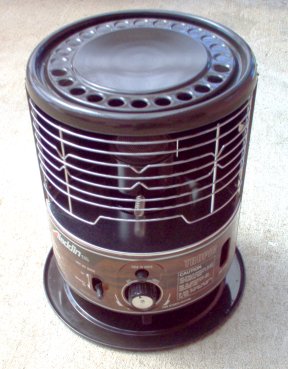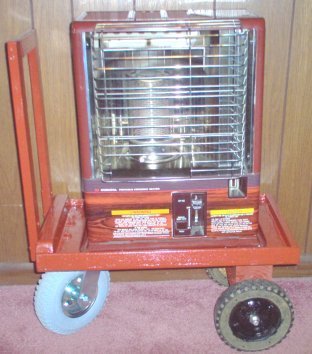|

WICKS TO FIT THE HEATERS LISTED
BELOW - AND MORE!
Unique Specialty wicks
for
19th Century lamps
|
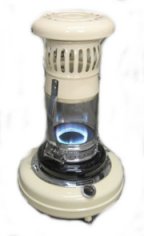
 . . . .
World's Largest Selection of Wicks!
Wicks for virtually every heater, stove and lamp made since 1850
Kerosene Heaters
Select
The Correct Size Heater
-
Convection
Heaters - Radiant
Heaters
Photos of Heaters -
Site Index for all things Perfection
There are many excellent kerosene heaters
available new, and excellent used heaters can
still be found at garage sales or on eBay...most simply need
routine maintenance and a new wick to work perfectly.
Be sure to read ALL of this page to see the
differences between convection heaters and radiant heaters, plus
recommendations for various heaters. If I do not like a
particular heater, it does not get my recommendation. Others
may like those heaters just fine. I do not sell kerosene
heaters and therefore have no "axe to grind" or profit to make
from my recommendations.
Kerosene heaters have been used for
over a century in complete safety. I have talked to experts in the
field, and no one has ever been able to find a single
instance of a house fire blamed on a kerosene heater. The same
certainly cannot be said for electric space heaters! Kerosene
heaters also have UL approval, and they could not attain that rating if
they were dangerous.
Kerosene heaters require no electricity to operate, and
kerosene can be safely stored for years in proper containers. The
freedom of having a means of heating your home without having to go to
town for fuel or depend upon others for your heat (the power grid and
natural gas) is liberating - and provides a considerable amount of safety
and security in your life. Look at the advertisement for "Perfection
Oil Heaters" from 1918. There were more than 3,000,000
Perfection Oil Heaters in use in 1918! The background of the ad
shows people lined up in the snow to purchase coal. The first line in the
advertisement is: "Perfection Oil Heaters saved the situation last
winter." What happened in 1917? The great influenza pandemic
after WW I. People who had a Perfection Oil Heater did not have to
line up with strangers to purchase coal...and catch the deadly flu that
killed millions of people. Those with a kerosene heater and a supply
of kerosene could avoid crowds - and survive. That message applies
equally today. With the current
situation of "Homeland Security" being very unstable, with
Muslim terrorists just waiting for the
chance to release a biological or chemical attack on our cities, and all
the warnings about a coming Avian flu pandemic, kerosene
heaters could again save the day for those smart enough to have a kerosene
heater and a supply of kerosene on hand.
SELECTING THE
CORRECT SIZE HEATER
FOR YOUR HOME
The design efficiency of almost all kerosene heaters occurs within a very
limited heat range: your choice of heating from 90% to 100% of the maximum
designed production. If a unit is rated at 22,300 BTUs, it will NOT
operate efficiently at much below 20,000 BTUs. That is a lot of heat, so
the choice of which model to purchase becomes critical to long term mental
stability. Generally, if you live in a temperate climate area,
use a factor of 10. If you live in an area that gets really cold, use a
factor of 20. Multiply that factor by the square footage of your
home. Let us say you have a 1000 square foot house. In a
temperate area, a 10,000 BTU/hr heater will heat that home on all but the
coldest days of the year - 1000 x 10 = 10,000 BTU/hr required.
If you live in a very cold area, like the upper mid-West or Canada where
the winter temperatures often fall into the teens or lower, then you need
a 20,000 BTU/hr heater (1000 x 20 = 20,000 BTU/hr required).
Of course you are never going to find a heater
with precisely the right heat output, but the idea is to come close.
And one (1) heater does not need to be used to equal the BTU's required.
In Canada, where it can get really cold, the best selling
wicks are #9 and #24 - wicks for small radiant heaters with an output in
the 8,000 BTU/hr range. The reason is they have long experience with
heating in cold weather, often off the grid, and know that using multiple
small heaters separated as far as possible in the house results all areas receiving
a relatively even heat. When the temperature is in the 40's, only one of the
heaters needs to be used to keep the house warm. Using one 23,000
BTU/hr heater would mean overheating one room in the house while the rooms
furthest away from the heater are still cool, and on warm days the large
heater would have to be turned off, then on again, in an attempt to
maintain an even heat. There is more on this subject below,
including list of wicks groups into sizes, and thus heat ranges which can
be expected.
THE DIFFERENT
TYPES OF KEROSENE HEATERS
Modern kerosene heaters have a dual combustion unit (catalytic converter)
with up to 99.9% fuel efficiency. (Older kerosene heaters were of
flame spreader
design.) Once broken in, a kerosene heater
produces virtually odor-free heating; only at start up and shut down do
they produce fumes, and then only for a few minutes. A couple of windows
opened for 5 minutes during that time takes care of the fumes, and then
need only be cracked an inch or so during normal operation of the heater.
Kerosene heaters themselves can be
classified into three distinctive subtypes: radiant, convection
and omni-directional radiant.
|
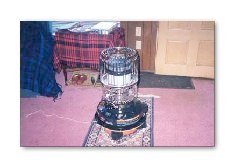 |
Toyotomi DC-100, aka Kero Sun, Toyostove, a
unique combination of radiant and convection. Toyotomi no
longer exports heaters. There was nothing sacred about their
heaters, and many other excellent heaters are readily available.
"Double Clean" was their registered trademark, a marketing tool, not
some magical technological breakthrough.
|
Both radiant and convection kerosene
heaters use a circular
wick to transport fuel via capillary action from the tank to the burner
unit, sometimes called a catalytic converter. That burner unit is the
heart of the heater.
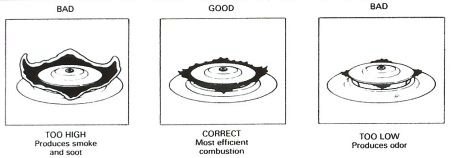
The wick height must be adjusted correctly for
clean burning, and it the same for both convection and radiant heaters.
A radiant heater has the
catalytic converter encased in a
glass cylinder (usually), with a half circle of reflective polished stainless steel behind it. The burner glows red and
reflects infrared heat waves directly to things (like people) - almost
instant heat output. Radiant
heaters
do produce some convective heat, but that is ancillary to their primary
design. Radiants are usually rated at 10,000 BTUs or less and project
that heat forward only; therefore, they may be placed against a wall or
window.
Convective heaters heat the air, which then heats the environment. The
burner unit is encased in a steel sleeve, not glass. Convective heaters
are generally rated at 20,000
BTUs or more and radiate heat in all directions. They need at least three
feet of clearance all around from combustible materials, or your home
could become uncomfortably hot.
One reason for knowing
the differences between radiant and convective units is because
radiant heaters provide heat to people in their path very quickly, whereas
with a convection heater, people must wait for the air itself to be
heated. BTU/hr
output is directly related to fuel consumption: radiants use only half
the fuel of convective heaters but put out only half the heat.
Another design feature which is unique is the focused
heat from a radiant heater. Objects feel the warmth almost
immediately, so while the air temperature in a room can be still be cool,
the people in that room are warm. The heat from a
radiant heater can feel wonderful to people with arthritis, for example.
But just as people feel that heat output almost immediately, so do plants.
If you need a heater for a greenhouse, use a convection heater...a
radiant heater with a glass chimney can burn the plants, but
radiant heaters with a metal catalytic converter do not have that intense
radiated heat.
As most kerosene heaters have one
optimum position for efficient operation, choosing the proper size heater
for the space to be heated is important: there is no low or medium heat
position, just "high" as the most efficient for the particular design.
Sorry. Open windows to regulate the household temperature. That is
why two radiant heaters spaced in different areas of the house are more
versatile and provide more even heat than a single large convection
heater...one or the other, or both radiant kerosene heaters can be used as needed.
|
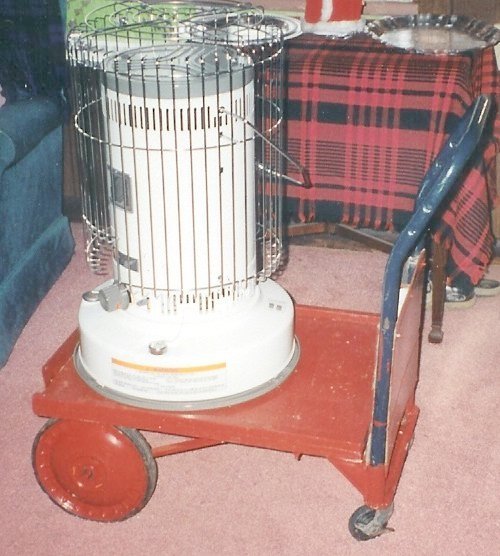 |
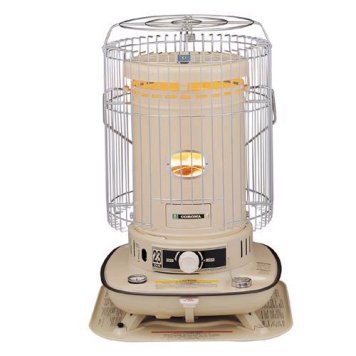 |
 |
|
Toyotomi WC 105
|
Corona from Manning |
Dyna-Glo from Northern |
CONVECTION
HEATERS
These heaters are
generally characterized by their circular tower design and safety
grillwork. Heat is distributed omni directionally, so they should be placed at least 3 feet
from any combustible surface -- often the middle of a room. The
Perfection (patented before 1849) and the Aladdin Blue Flame were the first widely distributed kerosene heaters,
but most of the units available now are visual clones of the Toyotomi (Toyostove
or Kero-Sun)
model WC-105. These units are 99.9% efficient with only a few fumes at
start up and shut down. They can be used as a primary heat source. Most
of the units now have an electric (battery powered) igniter, so they are
extremely easy to use.
There are a few problems
with using a convection heater. Most new
convection heaters are large - the heat output is over 22,000
BTUs. And they don't adjust down much, either. With an outside temperature
of 45 F and an inside temperature of 65 F, a Toyotomi WC 105 will drive
the temperature in our large home up to 75 F within 2 hours (set on
"low"!!!), and then must be shut down for 6 hours or so until needed
again. I now use the WC-105 to heat my uninsulated shop in the
winter, and for that purpose it is magnificent. People with large
homes in really cold country would find these heaters perfectly safe and
capable of heating their entire home quite easily, but one part of the
house may be quite warm while areas away from the heater are too cool.
Those with small homes or not living in the north would have more
versatility using two smaller heaters (usually radiant heaters) placed in
different areas of the house.
Small (10,000 BTU) convection heaters
used to be common, and can often be found at flea markets, on eBay, etc.
Make sure they are
in good condition, and you must know the make and model
number precisely. With that information, you can then
find which wick fits the heater. Wick size is directly proportional to heat
output, as the capillary action of the wick determines the amount of fuel
burned...the smaller the wick, the less fuel is burned, and the heat
output is lower.
The small diameter wicks
are from 2 to 2 15/16" in diameter, and are numbers 4, 4A, 4B, 6, 7, 12, 19, 24, 25, 30, 31,
34A, 37, 38, 39, 41, 42 and
42A.
If you live in the far North, you are probably using a
heater with a large diameter wick during the day for
maximum heat output. The
large diameter wicks are from 4 1/8"
to 4 3/4" in diameter, and are numbers 3, 3A, 3B, 3C, 3X, 5, 5A, 5B, 5C, 5X, 8, 13,
14, 18, 20, 21, 23, 28, 29, 32, 33 and 40.
Medium diameter wicks would be a good choice for nighttime
heaters in the far North and daytime heaters in more moderate climes. Medium diameter wick
numbers are 1, 2, 7, 10, 11, 15, 16, 17, 22, 26, 27, 34, 35 and 36.
So, when you purchase a heater for a specific purpose,
check the "All Heaters"
list by wick number to see what size wick that heater uses, and compare that
with the lists above of comparative wick diameters.
As the buyer of a heater, you have
your choice from thousands of different models. Choose wisely.
A heater that has been used can be
easily
cleaned and rebuilt, whereas a heater that has been abused is not a
good investment. You also have your choice of not buying heaters
that take certain wicks:
try to avoid heaters
that take wicks #15 or 16, 20, 20A, 20B because the wicks are expensive
and not available at times.
The list
alphabetical list
of heater wicks is a convenient way to find the precise wick for your
heater. I have the wicks in stock for immediate delivery at my
Wick Shop.
|
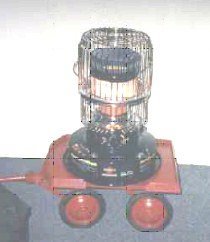 |
Most new convection
heaters are large and heavy, and the requirement of being placed in the
center of a room means they must be moved at times -- like outside for
refueling, or merely aside when not in use. I solved that problem by mounting
the wheels, axles and tongue assembly from a discarded child's wagon (courtesy
of the local county disposal site) onto a piece of 3/4" plywood measuring
18" x 24." The heater fits on the flat surface of the cart and can be
easily towed instead of being carried.
Building a cart
is easy.
|
Most convection heaters
have a fuel tank of about 2 gallons in capacity and will burn for 9 to
12 hours on one filling. The prices range from $125 to about $220, generally,
and wicks cost from $10 to $40 each, depending upon where you purchase
them and the design of the wick. Plan on purchasing at least 4 spare
wicks, just for the sake of safety.
The Corona
model #23-DK is an excellent, quality heater
now found only on eBay.
|
The KeroHeat Model CV-2230 is a
Heat Mate convection heater, a good heater which takes unpinned
wick #8. These heaters also have the model numbers
HMHC-2230, KH-250 or Mega 230 when sold by various vendors.
All are recommended because they are all the same. An
owner's manual can be downloaded
here.
CV-2230 = HMHc-2230 = KH-250 = Mega 230
= CV-23K the same heater with different decals.
Wick #8 for this heater is
here.
|
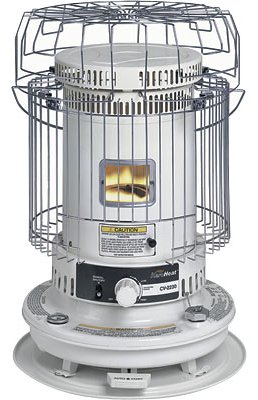 |
UPDATE October 28, 2022: Tractor Supply has the
CV-2230 the same as the heater
above, for $159.99 under their brand name ''Redstone model RS-235".
https://www.tractorsupply.com/tsc/product/redstone-23-500-btu-convection-kerosene-heater?cm_vc=-10005
. Do-It-Best hardware stores can
order these heaters. True Value Hardware lists only Dyna Glo
heaters at outrageous prices.
|
There are only two
manufacturers of heaters selling heaters in the US right now, Dyna
Glo and Heat Mate/Sengoku, though the heaters carry many brand labels.
*If a convection heater uses unpinned wick #8 it is a Heat Mate/Sengoku.
C20000, C20000A,
CV-2230 = HMHc-2230 = KH-250 = Mega 230 = CV-23K
= Redstone RS-235.
*If a convection heater uses pinned wick #3C, it was made by Dyna Glo.
DuraHeat DH2300, 2301, 2302, 2303, 2304, the KeroHeat CV-2300, Dyna Glo
CV2300, all models of RMC 95C & D + number, CV2300, 2301, 2301, 2303, 2304, etc,
KC-2404, - 2404b; KW-2400 (all series: 2400, 2401, 2402, 2403, 2404);
KW-24, -24B, -24C (all KW-24's and 2400's)
|
Quite a few people have asked me what I think
of the Kero-Sun Omni 105 convection heater. Actually, the
KeroSun Omni 105 cannot be considered as "a" heater, but rather a
syndrome of heaters which look remarkably similar on the exterior.
The early Omni 105 models E, F, G, H and I are
highly recommended, as they take pinless wicks and were of
very high quality. The later models J, K, L, M and N require a pinned
wick. They are no longer imported into the US. As such, Omni 105's
encountered are usually used. I would recommend an
Omni 105 over the Heat Mate and Dyna-Glo convection heaters if
it were in good condition and the price was right.
FIXING A
LOOSE CARRY HANDLE ON A CONVECTION HEATER (See
Regular Maintenance)
RADIANT
HEATERS
Radiant kerosene heaters project their heat in one direction, so they may
be placed against a wall, and they generally produce less than 10,000
BTUs. For small apartments
or homes, radiant heaters are the obvious choice, as they don't need to be
in the middle of cramped living space, and their heat output is not
overpowering. This allows continuous burning (and therefore eliminating
the constant shut off and restart that would be necessary for larger units
-- the major source of fumes from kerosene heaters) with the same or with
less overall fuel consumption. Choose a radiant kerosene heater to fit
your particular application, based upon your room design and the design of
the heater itself.
|
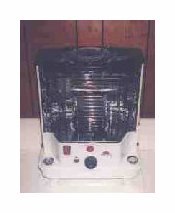 |
"Tony Sun" radiant heater. Unusual design with a bottom fuel
tank. This particular heater is not recommended. Note: NEVER use a radiant heater with a glass
chimney to heat a greenhouse! Radiant heaters with a metal
chimney are fine, as the radiated heat is not as intense. The
intense radiant heat from a glass chimney radiant will burn the plants.
|
The
design of most radiant heaters
allows for the convenient removal of the fuel tank for refilling, and the
quality of the units is such that they could be the primary heat source
for small homes or apartments. In larger homes, several radiant heaters
placed in different rooms (or as far apart as
possible) should provide enough heat for comfort. And dual units allow one
to be cooled down for refueling while another is still operating;
redundancy equals safety. Most of the radiant heaters will operate for 12
to 15 hours on one filling (approximately 1 gallon) of the fuel tank.
My personal prejudices on radiant
heaters centers on the quality (and price) of the heater and the shape of the
reflector. I have an inexpensive,
Chinese made Heat Mate HMHR-1101, a Toyostove RCA-87, a Corona
SX-2E, a Sharp-Pechka HSR-70F, two Aladdin Tropic's,
an Everglow P-E12 and an Aladdin TR2000. The Heat Mate HMHR-1101 has been
discontinued and replaced with the HMN/CTN-110.
Those with arthritis will appreciate the focused heat from a radiant
heater - it warms you directly, and that includes your stiff arthritic
joints, relieving pain and swelling.
The
instructions that come with kerosene heaters warn not to burn them at
night unattended. For my opinion on this, read
Burning
Kerosene Heaters at Night.
The
Corona SX-2E is unique is that it has a very deep parabolic
reflector, approximately 9" deep and 11" wide. It is ideally
suited for heating a long, narrow room if the heater is placed at
one end, as it projects focused radiant heat much better than
other radiant heaters with a shallow reflector. The Corona has a
small diameter wick with clips and the wick has a notch for the
igniter, so it is not adjustable at all and is almost impossible
to light with a match. However, the very high quality of the
Corona itself overcomes my built in prejudices about the wick. If
the D cell batteries that power the igniter are replaced every
year or two, the wick ignites easily. The Corona is also unique
in that it has a very tall, narrow catalytic converter. Combining
a small diameter wick with a tall catalytic converter means the
Corona burns exceptionally clean without any adjustments required.
Sometimes available from Manning Service,
and can be found on eBay. I also stock Corona heater wicks at my
Wick Shop.
The Newest Radiant Heater - and Recommended
UNTIL NOW, January, 2013
|
Introduced in October, 2009, this is a new slim line radiant from Heat Mate. This heater is an evolution of many
features of the Corona SX-2E (including an unpinned wick!), with the tall catalytic
converter for extra-clean burning. These small heaters
are quite fuel efficient and extremely useful. This heater
is sold under a variety of model names, all ending in -110:
MGN-110, CTN-110, HMN-110, under such names as
Kero Heat and Heat Mate. Many of the parts are made in Japan
and the quality is high.
I have wicks in stock for this heater. |
 |
From reports I have received from my customers the newest batch of
-110 heaters have several problems based on cheap OEM wicks. I can no longer
recommend them unless the wick is replaced. With one of my wicks they burn well, but not
with the cheap, thin wicks supplied with the heater.
(The original wick, #OS-65B, was an excellent wick.
It was replaced by #OS-0011, a thin dishrag of a wick. Some newer
heaters are now found with the excellent OS-65B wick installed.)
[1.4.2014. Miles thanks for the info on your site
about changing the cheap wick on the ctn-110,it made a world of
difference in startup and shutdown of the odor. My mom was so
impressed that i ordered her a ctn-110 and one of your fine wicks,
Thanks Again G. Sparks, KY]
UPDATE October 28, 2022: Tractor
Supply has the Heat Mate/Sengoku -110 under their brand name
''Redstone Model RS-110 for $149.95.
https://www.tractorsupply.com/tsc/product/redstone-10-000-btu-radiant-kerosene-heater?cm_vc=IOPDP1
The Heat
Mate HMHR 1101 actually burns cleaner (after adjusting the
wick height and centering the central air pillar wick gap) than the RCA-87,
as the catalytic converter is taller, thus having more surface
area to properly burn the hydrocarbons (kerosene) brought up via
the wick. The approximately 7" deep, 14" wide reflector is typical
of most kerosene radiant heaters, and works well in a typical
square room. The Heat Mate HMHR 1101 uses unpinned wicks, so wicks
can be trimmed 1/4" and readjusted higher several times, so wicks
last longer in use compared to pinned wicks. [Note: Some unpinned wicks can be trimmed,
depending upon the length.] I have used a Heat Mate HMHR 1101 for
16 winters now as our primary heat source. Update Dec. 23, 2009: Several readers have told me of problems with smoking with their new HMHR 1101. That is far
fewer complaints than I have heard from owners of DynaGlo radiant
heaters, though.
The Heat Mate HMHR 1101, KeroHeat CT-1101 and the KeroHeat CT-1101
(Canada) are identical because they are the HMHR 1101 with a
different decal. The KeroWorld RF1140 is the same heater
with an electric fan to distribute the heat. A few new ones
are still to be found but they were discontinued and replaced by
the excellent HMN/CTN-110.
Wick #1X for the -1101 is
here.
The CT-1101 (or clone) is a
recommended heater.
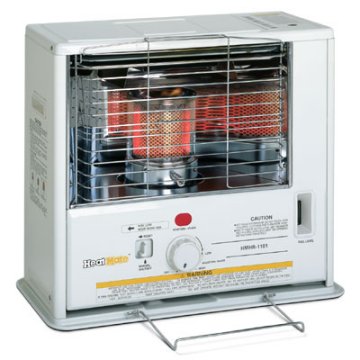
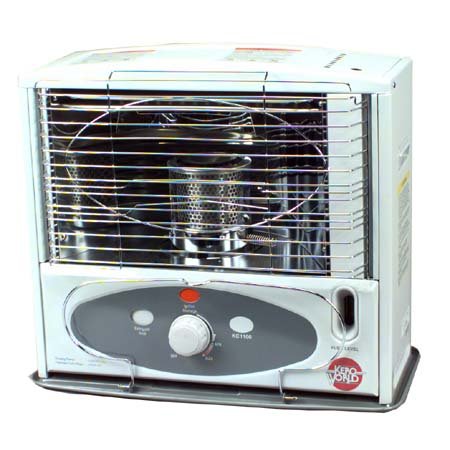
Heat Mate at left, Dyna Glo on the right. Note oval face plate on
the Dyna Glo
Notice the difference in the appearance of the heaters above.
The Heat Mate on the left has a flat front with a vertical sliding
shut-off switch to the left of the wick raising knob. The
Heat Mate is recommended because it is an excellent heater.
The Dyna Glo heater on the right has a distinctive oval face
plate.
The Dyna Glo RMC55R can be found sold under a wide variety of names,
such as KeroWorld CT-1104, and sometimes even with a Wal Mart
label. I don't care what the decal says - if it has
an oval face plate it is a Dyna Glo.
I recommend the Heat Mate instead of the Dyna Glo - they cost the
same, so why not get the superior heater?
Wick #1X for the Dyna Glo radiant is
here.
OMNI-DIRECTIONAL RADIANT HEATERS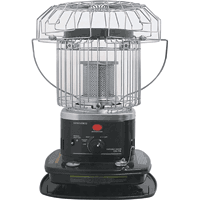
The Sengoku OR-78 OMNI-Radiant kerosene heater:
Early models were not recommended, but the latest incarnation is
pretty good with the qualifiers below. Notice the height between the top of the
catalytic converter and the fuel tank in the image above?
That is a long way for the wick to suck fuel to the top -
capillary action has its limits. It
is best if this heater is lighted on a full tank of fuel.
There is still the problem with the design: the OR-77/78 was
designed to use parts from the side-tank Heat Mate HMHR 1101.
The sump from the Heat Mate was actually welded into the bottom of
the fuel tank, so the wick does not reach the bottom of the font.
I commented on this to Sengoku back in 2002 and nothing was
changed (see comment below). Always
light this heater with a full tank of fuel!
|
The DuraHeat DH1050 is the latest
attempt at making a DC-100 "on the cheap." This heater
suffers many of the problems of the OR-77/78 series, including
a very long fuel lift, so it is best to always start this
heater burning on a full tank of fuel. The new
Kero Heat HMN-110 is a superior heater in my opinion.
I
have wicks available for this heater for immediate
delivery. |
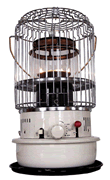 |
~~~~~~~~~~~~~
Used radiant heaters which are excellent
include the Aladdin Tropic, EverGlo P-E2, and too many others to
mention. The Aladdin Tropic, EverGlo P-E2 and Sharp-Pechka
are excellent little radiant
heaters for use in a motor home or travel trailer, as they are all
metal. That's right...even the catalytic converter chimney
is metal, yet they are a radiant! The Tropic is round, not
rectangular as are almost all other radiant heaters. They have a bottom fuel tank rather than the usual radiant drop-in tank, so there is no open sump to spill when being moved in a
motor home or trailer. Best of all, their low heat output of
7,800 Btu is sized correctly for the smaller areas encountered in
motor homes or travel trailers. These heaters also do not
have an insulated top plate, so they can be used for heating water
and rudimentary cooking. Finding one of these heaters is not easy, but they can be found at times on eBay
or garage sales, Saturday markets, etc.
Size matters!
Radiant heaters have handles near the top of each side - they are designed
to be carried. The Corona SX-2E is only 16" wide - a dream to carry.
The Heat Mate HMHR 1101 is 20" wide - still easy to carry. Toyotomi
likes to make them large - the RCA-87 is a full 24" wide: just try to
carry one through a door frame without barking your knuckles!
The instructions that
come with kerosene heaters warn not to burn them at night unattended.
For more information on this, read
Burning
Kerosene Heaters at Night.
NOTE:
All of the heaters mentioned above have an electric start mechanism using
batteries (usually two "D" size) to ignite the wick by heating a coil in
what appears to be a flashlight bulb without the glass globe.
Sometimes the heating coil will fail, but replacement is easy (push it in
and twist 1/4 turn) and I have them in stock at all times.
If the electric start system fails,
DO NOT use a kitchen match to ignite the wick!
Kitchen matches are too short (2 1/8"), and they have the nasty tendency
of the head falling off - right into the space where the catalytic
converter must seat firmly for proper combustion. Available at
almost every grocery store are bamboo skewers, and a pack of one
hundred 12" long skewers costs less than $1.30. Just light one end
of a bamboo skewer, raise the catalytic converter and light the wick.
Blow out the skewer, rub off the charred end, and it can be used dozens of
times...a single pack of skewers will last for years. Bamboo skewers
can also be used to light the stoves listed below.
Please
remember that all kerosene heaters need
regular maintenance.
Why have kerosene heaters at all?
First, they operate without the use of electricity, so your house can be
warm and livable even if the electric power goes out during a winter
storm. Second, kerosene itself can be stored in large quantities for
a long time, so you are not at the mercy of a utility grid in a prolonged
crisis. In actual use for heating a home, a gallon of kerosene will
provide about the same heat output as a wheelbarrow load of wood! If
everything went to heck in a hand basket, a hundred gallons of kerosene
and a good radiant heater would keep you safe in your home over a winter
without attracting attention, and that should be enough to keep your
family alive. If you are interested in preparations for emergency
situations, please visit my other web site,
www.EndTimesReport.com.
|
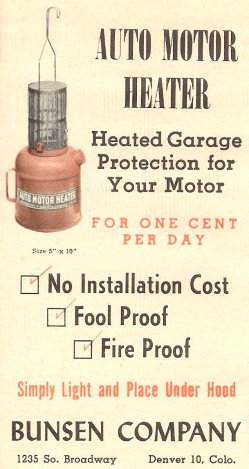 |
A MOST UNUSUAL KEROSENE HEATER
From the 1940's through
the 1960's, "Sports Heater Company" of Denver produced
little kerosene heaters to heat engine blocks during cold
weather. The auto motor heaters were sold under a wide
variety of names, but I suspect Bunsen in Denver actually
made them all. Used properly, these little heaters can be
used to heat a greenhouse, pump house or small building.
Over time, the
instructions for how to use these heaters became lost, but
the auto motor heaters themselves can often be found at
garage sales and on eBay. So, I give you the
original instructions that came with the heaters.
Instead of scanning the 6 point type on the instructions, I
have typed them...at least they will be readable.
|
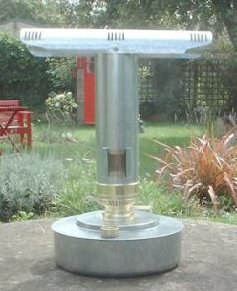 |
ANOTHER UNUSUAL HEATER
The British greenhouse
heater shown (left) has been made virtually unchanged since
1906. It uses two, 1" wide flat lamp wicks to produce
about 2,000 BTU. This heater is NOT for indoor
use. This heater
can be used to keep well pump houses from freezing,
and
if placed inside a sturdy hardware
hardware cloth cage with a secure access door, can be used
as a poultry house warmer to keep their water from freezing.
Available delivered airmail for about $50.00 USD from Norfolk Products, 55
Wilbury Way, Hitchin, Hertforshire SG4-OTW, England (UK).
E-mail
laurencenicholls@btconnect.com
|
----------------------------------------------
Review of the new HMN-110
I love this heater!! It is everything you said it was. Clean burning, and very easy to operate. I loved it so much I purchased another one. I
believe these 2 units will adequately serve my needs for back-up and supplemental heat. I have recommended the HMN-110 to several of my friends. I don't believe
anyone will be disappointed with this heater as long as they use a good quality kerosene. I am burning K-1 clear in my heaters and it is virtually odorless. In
case you post this on your site under customer testimonials I get my kerosene from WilcoHess in Charlotesville, VA or Sheetz stations in the Central VA and
Northern VA area. This fuel has proved to be very adequate.
Thanks again for recommending this awesome heater. Scott R. Central VA
---------------------------------------------
Comment from a
visitor, dated Feb. 17, 2004
You have know idea how much I have saved this winter on
gas bills!!! We have a very, very cold winter this year. A lot of temps
below 10 degrees at night. My bills would have been a killer. I bet I
would of had $250.00 to $300.00 per month. I used about $80.00 in kero and
my gas bill ran about $28.00!!!!!!! So I got off so cheap. I would not
have tried Kero heaters if not for reading your site. And both selections
of heater I made on the basis of your recommendation and have been "more
than pleased." Big thumbs up to you. And my house has been WARM!!!!!!
Something it has never been since I built it five years ago. It was always
a big battle over the thermostats. I would turn it down and my wife would
turn it up!!!!!! Now we are both happy and WARM!!!!!
---------------------------------
Comment from a reader about the Sengoku
OR-77, dated August 8, 2008
My blood turned to ice when you talked about the wick
not reaching the bottom of the fuel tank. Immediately i take apart my
OR-77, sure enough when the wick is at the optimal burning height, there
is about 1cm of space between the bottom of the wick, and the bottom of
the sump! So i put some fuel in and let it burn 'empty' without lowering
the wick. there is exactly 770ml (appx 1/5th gallon) of unburned fuel in
the bottom of the sump that the wick could not reach... how utterly
depressing.
I called Sengoku about this and it took about 15 min (me being very
persistent) before they finally 'got' that there was almost a LITER of
fuel in the bottom of the tank even after dry burning the wick. They were
actually pretty cool about it, after all they are not the engineers. I
tried to get a phone# for an engineer, but they dont have a design
representative in the USA (and i dont know japanese). They said they will
transfer this problem to japan.
In the meantime, as a fix i cut the bottom part of a new wick out, and put
it in the bottom of the sump. This transfers fuel to the burning wick.
When it burns dry there is now only 150ml of fuel in the tank that the
SUMP cannot reach. That gives about TWO MORE HOURS than before of burn
time before running the wick dry!
This may be a fix for those who are stuck with this heater.
The OR-77 is a beautiful machine. It burns clean and radiates heat in
every direction! Its lightweight and easy to manage. Everything about it
seems designed well exept for this one problem.
Thanks for your awesome webpage!
-Fred H., Arizona
~~~~~~~~~~
A question from
a visitor to this site, dated October 21, 2004
I just checked on kerosene and it is about $2.50 per gallon in a 55 gal
drum, $3.05 if you buy a gallon at a time. Doesn't look to reasonable.
Thanks, Bill A.
Answer:
It is absolutely true that the price of kerosene is
more than double what it was last year. Last month I had my tanks topped
off, and it cost me $2.04 per gallon. A year ago the price was $1.05 per
gallon, delivered, with a 100 gallon minimum. Last winter we heated the
house for less than $300.00, and this year would be double that. In some
parts of the country, kerosene is much less expensive than in Oregon. But
everywhere, electricity and natural gas are up in price quite a bit as
well.
Our Corona SX-2e will burn 3/4 of a gallon of kerosene
per 12 hours of use, but because the radiant aspect heats the walls and
furniture, the heater need not be on all the time as the residual heat
keeps the house warm for a long time. Because the heater is at full heat
output within minutes of being lit, people are warmed by the radiant heat
immediately, then the convection heat produced heats the air and the whole
house warms up. Therefore, we need not burn the heater at night except on
extremely cold nights when the temperature drops below freezing. On the
coldest nights of the winter, we can heat the house up to 70 F in the
morning with only an hour of burning a convection heater, then a radiant
heater will maintain that heat throughout the day.
The cost of electricity here is $0.06 per KWH, plus a
$33.00 per month meter charge. Natural gas is not available. Those who
heat with electricity often see electric utility bills of $200 to $300 per
month. Even at the inflated price of kerosene in this winter of 2005, our
monthly heating costs during the coldest months should not exceed $60.00
per month...considerably less than the cost of heating with electricity.
The heat output obtained from a gallon of kerosene
burned in an efficient kerosene heater is approximately the same as a
wheelbarrow full of wood. Firewood is over $200 per cord, so unless
firewood can be obtained for free, heating with kerosene space heaters is
less expensive than heating with a wood stove.
The cost savings of heating with kerosene space heaters
used to be phenomenal, but the high price of kerosene this year has
definitely cut into the tremendous advantage available in previous years.
Because of the war in Iraq and the unsettled conditions in the oil fields
of Nigeria, this winter of 2004/2005 will see unheard of prices for
kerosene. But the price of oil, now approaching $58 per barrel, will also
be reflected in increased costs for electricity, and natural gas is
already priced at an all time high.
This may well be a winter when mixing heating sources
could be advantageous. On days when the temperature is moderate, heat the
house quickly in the morning with a kerosene heater, then perhaps maintain
the heat during the day with a small electric space heater. Reading the
electric meter and keeping a record of those readings will let you know
when the point is reached when using an electric heater in no longer cost
effective.
Everyone will pay more for heating their homes this
winter. Kerosene space heaters are still very cost effective when compared
to other methods of home heating, plus they have the advantage of
providing heat when the electricity is out. And electricity WILL go out
this winter, either from storms or from terrorist actions. When that
happens, a kerosene space heater could keep your house warm and prevent
all the plumbing from freezing, resulting in a huge bill to replace broken
pipes, frozen and cracked toilets and water heaters, etc. Plus, you can
stay safely at home when others must go to a public shelter and get sick
from the crowded conditions!
Miles
Back to top of page
|
Home Page Click Here
Heater Information below
Lamp Wicks:
Center Draft Wicks - Wicks
available only from this Wick Shop.
Flat lamp wicks
Aladdin Lamp Wicks
& parts
Lamp Chimneys:
Center Draft Lamp
chimneys
from "Tiny" Junior to Mammoth lamps.
Fabulous "Sans Rival"
borosilicate chimney for 14''' Kosmos lamps
Student Lamp Sans Rival Chimney with
1 7/8" fitter!!!
Standard glass lamp chimneys
Sonnenbrenner Lamp Chimneys
Information on lamps:
Center Draft Kerosene Lamps
(Photos, information and history, etc)
Photos of
restored center draft lamps
Care, Feeding and Restoration of Center Draft
Lamps
(and wick
installation for many)
Center Draft
Lamp manufacturers and brand names
Lamp Chimneys
- Dimension of
nominal base diameter by make, model and "line".
Early American Metal Font & Specialty Lamps
Aladdin Lamp History
Aladdin Lamp Wicks & Chimneys,
Aladdin - Exploded burner views
Kosmos-Brenner lamps
and wicks
Flame Spreaders and
"Smoke
Consumers"
from Alex
Marrack
-
Vulcan, Imperial, Veritas,
Belgian, Hinks, Messenger's, Young's Court, etc.
Articles by Alex Marrack:
Home Page
Site Index
Site Index for all things Perfection
Kindler Wicking For Oil Stoves & Ranges
Kerosene Heaters
Alphabetical list of most kerosene heaters and the proper wick,
& cart checkout.
List by wick number and the heaters that fit them. (A
helpful guide for buying on eBay)
Measurements needed if you have an unlisted heater.
Care and Maintenance of Kerosene Heater Wicks
Installing Kerosene Heater Wicks - generic for unpinned
wicks
Owner's_Manuals & information for many kerosene heaters
Kerosene
Heaters - General types, how they work, recommendations
for some good ones - and those I would avoid.
Economic Benefits of
Kerosene Heaters
Kerosene
Heater Safety
Regular
maintenance
Troubleshooting kerosene heater common problems
Breaking
In New Kerosene Appliances
Burning
Kerosene Heaters at Night
WATER IN KEROSENE causing "dwindling" and poor
performance.
Flame Spreader Heaters
and Lamps -
A Century of Excellence
Kerosene Heater Carts
-
why carry your heater around?
Kerosene Fuel Primer
Sweet
Smelling Kerosene
Kerosene tank cradles
(photo)
Building a Cradle
HALLER "ORIGINEEL"
STOVES
KEROSENE
HEATERS MADE IN THE NETHERLANDS
Beatrice Boiling Stoves & Mini kerosene heaters
you can make
Sad Iron stoves; Wicks &
Installation instructions
Wicking For Oil
Burning "WICKLESS" Stoves & Ranges
Photo Album
Photos of
Wicks
Mail Order
Form
Kerosene Stoves, Lanterns and Ovens
Kerosene Stoves -
Recommendations on different models
Kerosene
Stove Maintenance and Storage
Butterfly A-822, 22 wick, all-aluminum
premium stove.
Butterfly #2487, 16 wick stove.
Butterfly #2412 Pressure
Stove;
instructions for virtually any pressure stove.
Butterfly #2418
Double Burner Stove;
good with any gravity flow stove.
Butterfly #2421
Oven for Kerosene Stoves
Butterfly #2641, 10 Wick Stove
-
the least expensive emergency stove.
Butterfly #2698 Cook Stove -
THE Best Heavy Duty Cook Stove.
Butterfly
#828R Pressure Lantern;
same for most pressure lanterns.
Back to top of page
|










